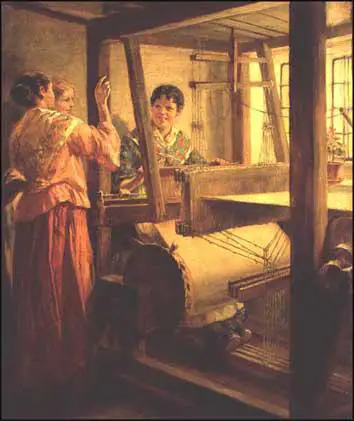History of the Handloom
The handloom was devised about 2,000 years ago and was brought to England by the Romans. The process consisted of interlacing one set of threads of yarn (the warp) with another (the weft). The warp threads are stretched lengthwise in the weaving loom. The weft, the cross-threads, are woven into the warp to make the cloth. Daniel Defoe, the author of A Tour Through the Whole Island of Great Britain (1724) "Among the manufacturers' houses are likewise scattered an infinite number of cottages or small dwellings, in which dwell the workmen which are employed, the women and children of whom, are always busy carding, spinning, etc. so that no hands being unemployed all can gain their bread, even from the youngest to the ancient; anyone above four years old works." (1)
According to Richard Guest: "The warp was placed between two beams about five feet apart; half way between the beams the warp passed through a frame work of looped threads, called healds, each alternative thread of the warp going through one heald, and the other threads through the other heald. The healds were worked by two treadles, which upon one being put down by the foot, raised one half of the healds and every second thread of the warp; the shuttle which contained the weft was then thrown by the right hand between the threads which were at rest, and the second or alternative threads raised by the treadle and the healds; the shuttle was caught on the other side by the left hand, and the weft thus transversely shot between the threads of the warp." (2)

Weaving remained unchanged for hundreds of years until John Kay devised the flying shuttle, which enabled a weaver to knock the shuttle across the loom and back again using one hand only. The speed of weaving was doubled; and a single weaver could make cloths of any width, whereas previously two men had sat together at a loom to make broad cloth. By 1800 it was estimated that there were 250,000 handlooms in Britain. (3)
Primary Sources
(1) Richard Guest, A History of the Cotton Manufacture (1823)
The warp was placed between two beams about five feet apart; half way between the beams the warp passed through a frame work of looped threads, called healds, each alternative thread of the warp going through one heald, and the other threads through the other heald. The healds were worked by two treadles, which upon one being put down by the foot, raised one half of the healds and every second thread of the warp; the shuttle which contained the weft was then thrown by the right hand between the threads which were at rest, and the second or alternative threads raised by the treadle and the healds; the shuttle was caught on the other side by the left hand, and the weft thus transversely shot between the threads of the warp.
(2) Edward Baines, The History of the Cotton Manufacture (1935)
In 1738, Mr. John Kay, a native of Bury, in Lancashire, then residing at Colchester, where the woollen manufacture was at that time carried on, suggested a mode of throwing the shuttle, which enabled the weaver to make nearly twice as much cloth as he could make before. The old mode was, to throw the shuttle with the hand, which required a constant extension of the hands to each side of the warp. By the new plan, the lathe (in which the shuttle runs) was lengthened a foot at either end; and, by means of two strings attached to the opposite ends of the lathe, and both held by a peg in the weaver's hand, he, with a slight and sudden pluck, was able to give the proper impulse to the shuttle. The shuttle thus impelled was called the flying-shuttle, and the peg called the picking-peg (i.e. the throwing peg). This simple contrivance was a great saving of time and exertion to the weaver, and enabled one man to weave the widest cloth, which had before required two persons.
Student Activities
Child Labour Simulation (Teacher Notes)
Richard Arkwright and the Factory System (Answer Commentary)
Robert Owen and New Lanark (Answer Commentary)
James Watt and Steam Power (Answer Commentary)
The Domestic System (Answer Commentary)
